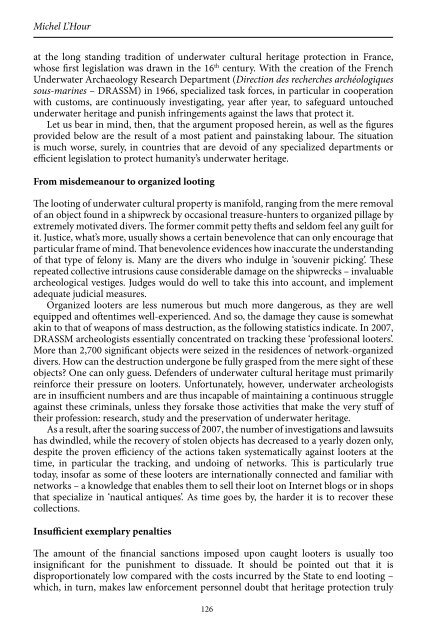Countering
Book_observatory_illicit_traffic_version%20issuu
Book_observatory_illicit_traffic_version%20issuu
You also want an ePaper? Increase the reach of your titles
YUMPU automatically turns print PDFs into web optimized ePapers that Google loves.
A Fight Yet To Be Waged<br />
is a crucial stake. It stands to reason that the same individuals involved in previous<br />
lootings should continue their illicit activity. Thus will the situation remain, until it is<br />
decided that theft and the destruction of maritime cultural objects are to be sanctioned<br />
more severely. Justice, in France, seems to have taken this in, since underwater looting<br />
is now prosecuted as are theft or property damage. The Montpellier Court of Justice<br />
has sentenced shipwreck looters to prison. The case is currently under appeal but it is a<br />
cornerstone that shows, surely, that authorities understand better the consequences of<br />
such criminal acts – the irreversible destruction of our common heritage.<br />
Much work is still needed, for it appears that judges are, by and large, hardly aware<br />
of the impact of the destruction of archeological sites, i.e. prejudice in the form of<br />
disappearance of historical traces. Because of this lack of understanding, judges are<br />
likely to leave it unpunished. Unique remnants of our past have been callously destroyed<br />
by predators – resulting in the irretrievable loss of site integrity – only to keep artifacts<br />
whose pristine condition guarantees a quick sale on the market. The only criteria<br />
jurisdictions retain, however, is the mercantile value of the object instead of the scientific<br />
worth of the sites destroyed. Moral prejudice would have, in fact a much higher value. It<br />
is adamant that mentalities change and that the extent of the moral prejudice provoked<br />
hence be taken into account by judges, once and for all.<br />
Looting hot spots<br />
Underwater heritage is at risk throughout the world. Keenly attuned as they are with<br />
the environment they revolve around, looters, however, typically operate within specific<br />
areas. Their primary targets are countries with limited protection: absent or insufficient<br />
legislation, few coastguards (if any), low income or poverty – fertile ground for corruption<br />
as local authorities may easily be bought to turn a blind eye or even collaborate. Some<br />
countries in the Caribbean (Haiti, Santo Domingo, etc.) or Indian Ocean regions<br />
(Madagascar, Mozambique, etc.) are often rampaged by traffickers and uncivil divers<br />
from Europe, the United States, Australia, South Africa, and increasingly, Asia, and<br />
China in particular. While the sale of stolen objects remains discrete an activity, Internet<br />
is becoming the main platform whereby illegally removed objects are sold, e.g. an 18 th<br />
century French 74-gunship of the line Scipion that was nearby Saint-Domingue, or<br />
bronze Portuguese canons stolen from an underwater archeological site in Madagascar.<br />
Experts are enclined to think that this is the location of the vestiges of the San Ildefonso,<br />
sunk on the Star Bank in 1527. Few are the solutions available, since international law<br />
enforcement forces have insufficient investigative capacity, with most of their agents<br />
assigned to cases of theft concerning more usual and easily identifiable movable cultural<br />
property such as objects stolen from places of worship, museums, castles, etc.<br />
When heritage becomes Mafia interest<br />
Underwater cultural heritage is less visible, and is therefore less the object of attention.<br />
It remains unlisted in INTERPOL or local enforcement authority databases, and is<br />
seldom searched for during routine controls. Things will only change when training in<br />
underwater heritage identification is provided to police staff. In addition, underwater<br />
archeology specialists are too few to train new recruits. This situation clearly explains<br />
why stolen treasures are still found on the market nowadays, world renowned auction<br />
houses still sell 3 rd century BC coins from the Roman treasure of Lava – although it is<br />
127


